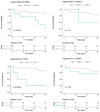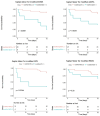Better Performance of Modified Scoring Systems to Predict the Clinical Outcomes of Vibrio Bacteremia in the Emergency Department: An Observational Study
- PMID: 38673012
- PMCID: PMC11051138
- DOI: 10.3390/jpm14040385
Better Performance of Modified Scoring Systems to Predict the Clinical Outcomes of Vibrio Bacteremia in the Emergency Department: An Observational Study
Abstract
Background: Vibrio is a genus of Gram-negative bacteria found in various aquatic environments, including saltwater and freshwater. Vibrio bacteremia can lead to sepsis, a potentially life-threatening condition in which the immune system enters overdrive in response to the disease, causing widespread inflammation and damage to tissues and organs. V. vulnificus had the highest case fatality rate (39%) of all reported foodborne infections in the United States and a high mortality rate in Asia, including Taiwan. Numerous scoring systems have been created to estimate the mortality risk in the emergency department (ED). However, there are no specific scoring systems to predict the mortality risk of Vibrio bacteremia. Therefore, this study modified the existing scoring systems to better predict the mortality risk of Vibrio bacteremia.
Methods: Cases of Vibrio bacteremia were diagnosed based on the results from at least one blood culture in the ED. Patient data were extracted from the electronic clinical database, covering January 2012 to December 2021. The primary outcome was in-hospital mortality.This study used univariate and multivariate analyses to evaluate the mortality risk.
Results: This study enrolled 36 patients diagnosed with Vibrio bacteremia, including 23 males (63.9%) and 13 females (36.1%), with a mean age of 65.1 ± 15.7 years. The in-hospital mortality rate amounted to 25% (9/36), with 31.5% in V. vulnificus (6/19) and 17.6% in V. non-vulnificus (3/17). The non-survivors demonstrated higher MEDS (10.3 ± 2.4) than the survivors (6.2 ± 4.1) (p = 0.002). Concerning the qSOFA, the survivors scored 0.3 ± 0.5, and the non-survivors displayed a score of 0.6 ± 0.7 (p = 0.387). The AUC of the ROC for the MEDS and qSOFA was 0.833 and 0.599, respectively. This study modified the scoring systems with other predictive factors, including BUN and pH. The AUC of the ROC for the modified MEDS and qSOFA reached up to 0.852 and 0.802, respectively.
Conclusion: The MEDS could serve as reliable indicators for forecasting the mortality rate of patients grappling with Vibrio bacteremia. This study modified the MEDS and qSOFA to strengthen the predictive performance of mortality risk for Vibrio bacteremia. We advocate the prompt initiation of targeted therapeutic interventions and judicious antibiotic treatments to curb fatality rates.
Keywords: Vibrio; bacteremia; mortality risk; scoring systems; seasonal distribution.
Conflict of interest statement
The authors declare no conflicts of interest.
Figures






Similar articles
-
Good Performance of Revised Scoring Systems in Predicting Clinical Outcomes of Aeromonas Bacteremia in the Emergency Department: A Retrospective Observational Study.Diagnostics (Basel). 2024 Jan 5;14(2):124. doi: 10.3390/diagnostics14020124. Diagnostics (Basel). 2024. PMID: 38248001 Free PMC article.
-
Risk Factors and Scoring Systems to Predict the Mortality Risk of Afebrile Adult Patients with Monomicrobial Gram-Negative Bacteremia: A 10-Year Observational Study in the Emergency Department.Diagnostics (Basel). 2024 Apr 23;14(9):869. doi: 10.3390/diagnostics14090869. Diagnostics (Basel). 2024. PMID: 38732284 Free PMC article.
-
Performance of Scoring Systems in Predicting Clinical Outcomes in Patients with Bacteremia of Listeria monocytogenes: A 9-Year Hospital-Based Study.Biology (Basel). 2021 Oct 21;10(11):1073. doi: 10.3390/biology10111073. Biology (Basel). 2021. PMID: 34827066 Free PMC article.
-
Predicting mortality in adult patients with sepsis in the emergency department by using combinations of biomarkers and clinical scoring systems: a systematic review.BMC Emerg Med. 2021 Jun 13;21(1):70. doi: 10.1186/s12873-021-00461-z. BMC Emerg Med. 2021. PMID: 34120605 Free PMC article.
-
Performance of the MEDS score in predicting mortality among emergency department patients with a suspected infection: a meta-analysis.Emerg Med J. 2020 Apr;37(4):232-239. doi: 10.1136/emermed-2019-208901. Epub 2019 Dec 13. Emerg Med J. 2020. PMID: 31836584
Cited by
-
Vibrio vulnificus-A Review with a Special Focus on Sepsis.Microorganisms. 2025 Jan 10;13(1):128. doi: 10.3390/microorganisms13010128. Microorganisms. 2025. PMID: 39858896 Free PMC article. Review.
References
-
- Sampaio A., Silva V., Poeta P., Aonofriesei F. Vibrio spp.: Life Strategies, Ecology, and Risks in a Changing Environment. Diversity. 2022;14:97. doi: 10.3390/d14020097. - DOI
Grants and funding
LinkOut - more resources
Full Text Sources

